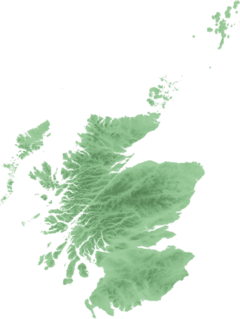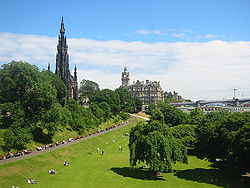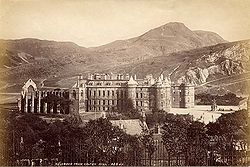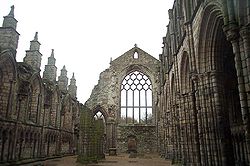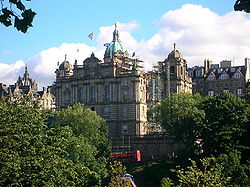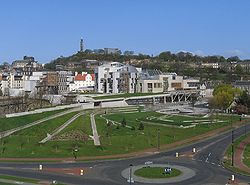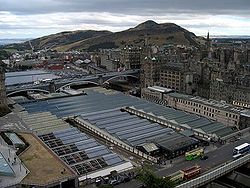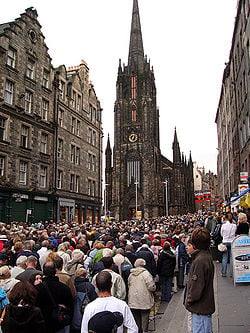Difference between revisions of "Edinburgh" - New World Encyclopedia
Mary Anglin (talk | contribs) (Images OK) |
Mary Anglin (talk | contribs) m (→Geography) |
||
| Line 42: | Line 42: | ||
==Geography== | ==Geography== | ||
| − | |||
[[Image:Princes Street Gardens.jpg|thumb|left|250px|Looking northeast across part of [[Princes Street Gardens]].]] | [[Image:Princes Street Gardens.jpg|thumb|left|250px|Looking northeast across part of [[Princes Street Gardens]].]] | ||
[[Image:EdinburghFromCaltonHill.jpg|thumb|left|250px|View over ''Auld Reekie'', with the [[Dugald Stewart Monument]] in the foreground]] | [[Image:EdinburghFromCaltonHill.jpg|thumb|left|250px|View over ''Auld Reekie'', with the [[Dugald Stewart Monument]] in the foreground]] | ||
| − | The origin of the city's name in English is understood to come from the [[Brythonic languages|Brythonic]] ''Din Eidyn'' (Fort of Eidyn) from the time when it was a [[Gododdin]] [[hillfort]]. | + | The origin of the city's name in[[ English language|English]] is understood to come from the [[Brythonic languages|Brythonic]] ''Din Eidyn'' (Fort of Eidyn) from the time when it was a [[Gododdin]] [[hillfort]]. It came to be known to the English, the [[Bernicia]]n [[Angles]], as ''Edin-burh''. The ''[[burgh]]'' means "fortress" or "walled group of buildings", while ''Edin'' is untranslated. |
| − | The city is affectionately nicknamed ''Auld Reekie'' | + | The city is affectionately nicknamed ''Auld Reekie'' ([[Scots language|Scots]] for ''Old Smoky''), because of smoke from[[coal]] and wood fires. Edinburgh has also been known as ''Dunedin'', deriving from the [[Scottish Gaelic]], ''Dùn Èideann''. [[Dunedin, New Zealand]], was originally called "New Edinburgh" and is still nicknamed the "Edinburgh of the South". |
| − | Edinburgh occupies seven miles (11km) of the north-facing slope on the southern shore of the Firth of Forth, which is an arm of the North Sea reaching west into the Scottish Lowlands. Much of the city lies among craggy upthrusts of lava and hills — the valleys between were scoured by Pleistocene Epoch glacial action. | + | Edinburgh occupies seven miles (11km) of the north-facing slope on the southern shore of the Firth of Forth, which is an arm of the [[North Sea]] reaching west into the Scottish Lowlands. Much of the city lies among craggy upthrusts of [[lava]] and hills — the valleys between were scoured by [[Pleistocene]] Epoch glacial action. |
| − | Arthur’s Seat has an elevation of 823 feet (251 | + | Arthur’s Seat has an elevation of 823 feet (251 meters), while Castle Rock, a [[basalt]] plug sealing an extinct [[volcano]], stands 250 feet (76 meters) above the valley floor and is crowned by the famous [[Edinburgh Castle]]. |
| − | Edinburgh has a [[temperate]] [[maritime climate]], which is relatively mild despite its northerly [[latitude]]. | + | Edinburgh has a [[temperate]] [[maritime climate]], which is relatively mild despite its northerly [[latitude]]. [[Winter]]s are especially mild, with the average maximum daytime temperature in January of 43.2°F (6.2°C), rising to an average maximum of around 65.8°F (18.8°C) in July. The proximity of the city to the sea mitigates any extremes of climate. Edinburgh is renowned as a windy city. Mean annual precipitation is 26.3 inches (668mm). |
| − | The historic | + | The historic center of Edinburgh is divided by the broad green swathe of [[Princes Street Gardens]]. To the south is [[Edinburgh Castle]], perched atop the extinct volcanic crag, and the long sweep of the [[Old Town, Edinburgh|Old Town]] trailing after it along the ridge. To the north lies [[Princes Street]] and the [[New Town, Edinburgh|New Town]]. The gardens were begun in 1816 on [[bog]]land which had once been the [[Nor Loch]]. To the immediate west of the castle lies the financial district, housing insurance and banking buildings. |
[[Image:Edinburgh wiki.jpg|thumb|800px|center|Panoramic view of Edinburgh from the top of Arthur's Seat.]] | [[Image:Edinburgh wiki.jpg|thumb|800px|center|Panoramic view of Edinburgh from the top of Arthur's Seat.]] | ||
Revision as of 22:09, 19 October 2008
| City of Edinburgh | |
| Scottish Gaelic: Dùn Èideann | |
| Scots: Edinburgh, Embra, Embro, Edinburrie | |
| Auld Reekie, Athens of the North, Capital of Scotland | |
|
File:EdinburghFromCastle.jpg
|
|
|
City of Edinburgh shown within Scotland | |
| Area[1] | 100 sq mi (259 km²) |
|---|---|
| Population | 457,830 (June 30, 2005) |
| Urban | 1,250,000 |
| OS grid reference | |
| - London | 332 miles (535 km) SSE |
| Council area | City of Edinburgh |
| Lieutenancy area | Edinburgh |
| Constituent country | Scotland |
| Sovereign state | United Kingdom |
| Post town | EDINBURGH |
| Postcode district | EH1-EH13; EH14 (part); EH15-EH17 |
| Dialling code | 0131 |
| Police | |
| Fire | |
| Ambulance | Scottish |
| European Parliament | Scotland |
| UK Parliament | Edinburgh South |
| Edinburgh West | |
| Edinburgh South West | |
| Edinburgh North and Leith Edinburgh East |
|
| Scottish Parliament | Edinburgh North and Leith |
| Edinburgh Central | |
| Edinburgh East and Musselburgh Edinburgh Pentlands Edinburgh South Edinburgh West Lothians |
|
| List of places: UK • Scotland | |
Edinburgh (pronounced /ˈɛdɪnb(ə)rə/; Scottish Gaelic: 'Dùn Èideann'), located in the south-east of Scotland, is the capital of Scotland and is its second largest city after Glasgow. Owing to its rugged setting and vast collection of Medieval and Georgian architecture, including numerous stone tenements, it is among the most picturesque cities in Europe.
The city was a center of the Enlightenment, led by the University of Edinburgh, earning it the nickname Athens of the North. The Old Town and New Town districts of Edinburgh were listed as a UNESCO World Heritage Site in 1995. There are over 4500 listed buildings within the city.[2]
The city attracts one million visitors a year, and is the second most visited tourist destination in the United Kingdom, after London.[3]
Geography
The origin of the city's name inEnglish is understood to come from the Brythonic Din Eidyn (Fort of Eidyn) from the time when it was a Gododdin hillfort. It came to be known to the English, the Bernician Angles, as Edin-burh. The burgh means "fortress" or "walled group of buildings", while Edin is untranslated.
The city is affectionately nicknamed Auld Reekie (Scots for Old Smoky), because of smoke fromcoal and wood fires. Edinburgh has also been known as Dunedin, deriving from the Scottish Gaelic, Dùn Èideann. Dunedin, New Zealand, was originally called "New Edinburgh" and is still nicknamed the "Edinburgh of the South".
Edinburgh occupies seven miles (11km) of the north-facing slope on the southern shore of the Firth of Forth, which is an arm of the North Sea reaching west into the Scottish Lowlands. Much of the city lies among craggy upthrusts of lava and hills — the valleys between were scoured by Pleistocene Epoch glacial action.
Arthur’s Seat has an elevation of 823 feet (251 meters), while Castle Rock, a basalt plug sealing an extinct volcano, stands 250 feet (76 meters) above the valley floor and is crowned by the famous Edinburgh Castle.
Edinburgh has a temperate maritime climate, which is relatively mild despite its northerly latitude. Winters are especially mild, with the average maximum daytime temperature in January of 43.2°F (6.2°C), rising to an average maximum of around 65.8°F (18.8°C) in July. The proximity of the city to the sea mitigates any extremes of climate. Edinburgh is renowned as a windy city. Mean annual precipitation is 26.3 inches (668mm).
The historic center of Edinburgh is divided by the broad green swathe of Princes Street Gardens. To the south is Edinburgh Castle, perched atop the extinct volcanic crag, and the long sweep of the Old Town trailing after it along the ridge. To the north lies Princes Street and the New Town. The gardens were begun in 1816 on bogland which had once been the Nor Loch. To the immediate west of the castle lies the financial district, housing insurance and banking buildings.
History
Evidence of human settlement on the shores of the Firth of Forth dates back to 7000 B.C.E., while archaeological excavations reveal that the Castle Rock has been occupied since about 1000 B.C.E.
Roman forts were built at Cramond and Inveresk on the western and eastern margins of the present-day city during the second century C.E. A Celtic tribe known as the Votadini was based at Traprain Law, a hill about 20 miles (30km) east of the modern city at that time, and moved to Castle Rock around 500, after the Romans departed.
In 580, when a military campaign started in Edinburgh (Din Etin), commemorated in the Welsh poem Y Gododdin, most of the inhabitants of southern Scotland spoke British, the ancestor of modern Welsh. Around 638, Edinburgh was besieged, possibly marking the passing of control of the fort of Din Etin from the Gododdin to the Northumbrian English, led at this time by Oswald of Northumbria (604-642).
However, in the seventh century, Edwin of Northumbria (586-633), an Angle of Deira (the southern part of the Kingdom of Northumbria, captured this location and named it Eiden's burgh (burgh being an old word for "fort"). Edwin made Edinburgh his capital and from it carved out a kingdom, which stretched to the river Humber in England, known as Northumbria/Bernicia.
By 731, Edinburgh was firmly within the kingdom of Northumbria at the time of Bede (672-735), who completed his History in that year. Around 960, Scots captured Edinburgh during the reign of Illulb mac Custantin (954-62). King David I (1085-1153) granted Edinburgh the status of a Royal burgh in 1125, which promoted the manufacture of cloth and trade in the city.
Because of Edinburgh's earlier Anglo-Saxon rule, Edinburgh and the Border counties lay in a disputed zone between England and Scotland, England claiming all Anglo-Saxon Domains as English territory, and Scotland claiming all territory as far south as Hadrians Wall. This resulted in a long series of border wars and clashes, which often left Edinburgh Castle under English control.
After the Wars of Independence (1296–1328), fought against England, Edinburgh became Scotland’s main trading center. In 1329, King Robert the Bruce (reigned 1306–1329) confirmed Edinburgh's privileges as a royal burgh and established a port at Leith. At that time, Edinburgh was renowned for its stench — domestic refuse and offal from skinners, butchers, and fishmongers were dumped on either side of the main street.
King James IV of Scotland (reigned 1488–1513) moved the Royal Court from Stirling to Holyrood, making Edinburgh Scotland's capital. James V established the Court of Session, the central civil-law court, in Edinburgh in 1532.
In 1603, following King James VI's accession to the English and Irish Thrones, James VI (1566-1625) instituted the first executive Parliament of Scotland which met in the Great Hall of Edinburgh Castle, later finding a home in the Tolbooth, before moving to purpose-built Parliament House, Edinburgh, which later became home to the Supreme Courts of Scotland
In 1639, disputes over the planned merger, between the Presbyterian Church and the Anglican Church, and the demands by Charles I, to reunify the divided St Giles' Cathedral, led to the Bishops Wars (1639-1640_, which in turn led to the English Civil War (1641-1653), and the eventual the occupation of Edinburgh by Commonwealth forces of Oliver Cromwell. In the 1670s, King Charles II commissioned the rebuilding of Holyrood Palace.
In 1707, the Act of Union, which joined the Kingdom of England and the Kingdom of Scotland (previously separate states) was signed in a cellar in Parliament Square, and Edinburgh lost all independent political life. A surge of building took place within the Old Town.
Edinburgh was occupied by Jacobite forces during the last Jacobite rebellion in 1746, which aimed to return descendants of the Scottish House of Stuart to the throne of England. It was subsequently occupied by British forces under the command of the Prince William, Duke of Cumberland (1721-1765), leading to a long period of reprisals.
From 1772, after the draining of the Nor Loch, which had been both the city's water supply and place for dumping sewage, Edinburgh expanded beyond the Old Town. The Nor Loch area became Castle Gardens. The New Town resulted from a 1776 design competition, which created a rigid, ordered grid, which fitted well with enlightenment ideas of rationality. George St, Frederick St, Hanover St, Queen St, and Prince’s St, the main shopping street in Edinburgh, were named in honour of the Hanoverian monarch on the English throne.
A number of Scottish intellectuals, many from Edinburgh, including political economist Adam Smith (1723-1790) and philosopher David Hume (1711-1776), felt it was a time for Scotland to modernise. They promoted the idea of Britishness, and led the British Empire into a golden age of economic and social reform and prosperity. Edinburgh became a cultural centre, earning it the nickname "Athens of the North", both due to the Greco-Roman style of the New Towns' architecture, as well as the rise of the Scottish/British intellectual elite there. The creator of the historical novel, Sir Walter Scott (1771-1832), was another Edinburgh native.
Excess soil from the construction of the New Town was dumped into the loch, creating what became The Mound. In the mid-19th century the National Gallery of Scotland and Royal Scottish Academy Building were built on The Mound, and tunnels to Waverley Station driven through it.
From 1830 to World War I (1914-1918) Edinburgh, like many cities, industrialised, but most of this happened in Leith. Edinburgh did not grow greatly in size, but the increase in the labouring population brought overcrowding, malnutrition, and epidemics. Glasgow soon replaced it as the largest and most prosperous city in Scotland, becoming the industrial, commercial and trade centre, while Edinburgh remained Scotland's intellectual and cultural centre.
Sir Patrick Geddes (1854-1932), a pioneer of urban planning, tried to revive the Old Town in the 1890s. Nationalist poet Hugh MacDiarmid (1892-1978) made Edinburgh the centre of the Scottish political and literary renaissance in the 1920s and 1930s
After World War II (1939-1945), Edinburgh developed as a center for higher education, especially in medicine and surgery, electronics, and artificial intelligence. The cultural life of the city expanded, especially through the Edinburgh International Festival, which began in 1947. The city has begun a movement to conserve its stone architecture.
A new Scottish Parliament and government was established in Edinburgh in 1999, re-establishing the city as the capital and political centre of Scotland.
Government
As part of the United Kingdom, Scotland is a liberal democracy and a constitutional monarchy. In elections to the House of Commons of the Parliament of the United Kingdom, the city is divided into five first-past-the-post constituencies. As capital of Scotland, Edinburgh is host to the national unicameral legislature, the Scottish Parliament, which opened in September 2004. The Scottish Parliament devolves responsibility for health, education, housing, economic development, regional transport, the environment, and agriculture. For elections to the European Parliament, Edinburgh is within the Scotland constituency.
Edinburgh constitutes one of the 32 council areas of Scotland and is represented by the City of Edinburgh Council, comprising 58 elected councillors, each representing a multi-member electoral ward, and led by the Lord Provost. Council elections are held on a four year cycle. Each of the multi-member wards elects three or four councillors by the single transferable vote system.
Economy
Within the United Kingdom, Edinburgh's economy is second to London — the city's GDP per capita was measured at US$55,000 in 2004, compared with London's US$72,500 in 2005. The city's economy is centered around banking, financial services, higher education, tourism, and government, as well as its legal system.
Banking has been a part of the economic life of Edinburgh for over 300 years with the invention of capitalism in the city, with the establishment of the Bank of Scotland by an act of the original Parliament of Scotland in 1695. The city's financial services industry, particularly insurance and investment, Edinburgh has emerged as Europe's sixth largest financial centre.[4] The Royal Bank of Scotland is the fifth largest in the world by market capitalisation.
Tourism is an important economic mainstay, enhanced by the city's status as a World Heritage Site, and the annual Edinburgh Festivals, which generates in excess of £100-million for the city.[5]
Manufacturing has never had as strong presence in Edinburgh as Glasgow. However, brewing, publishing, and electronics have maintained a foothold. Unemployment in Edinburgh was low at 2.2 percent in 2007, below the Scottish average.[6]
Edinburgh is a transport hub, with arterial road and rail routes that connect the city to the rest of Scotland and with England. The Forth Bridge and the Forth Road Bridge are both engineering feats. A bus service provides most public transport. Construction began in 2007 on a light rail tram line to connect Edinburgh Airport and Granton via the city centre and Leith Walk.
Leith is the port of Edinburgh and retains a separate identity. Redevelopment attracted the business of a number of companies which provide cruises to Norway, Sweden, Denmark, Germany, and the Netherlands. Leith has the decommissioned Royal Yacht Britannia. Large parts of the port have been redeveloped into retail and residential buildings. Edinburgh is served by Edinburgh Airport, located about eight miles (13km) to the west of the city.
Demographics
The City of Edinburgh council area had an estimated population of 463,510 in 2006.[7] The population of the greater Edinburgh area was 1.25 million and was projected to grow to 1.33 million by 2020. Though Edinburgh's population is ageing, there is a large and transient population of around 100,000 young students.[8]
Edinburgh is a cosmopolitan city. The main ethnic groups are: Scottish (including those of mixed English and Scottish descent and those born in Scotland of full English descent) 82 percent, English 13 percent, Polish two percent, Chinese one percent, Indian one percent, and Pakistani one percent. The other two percent includes French, Spanish, Lithuanians, Australians, New Zealanders, South Africans, Chileans, Malaysians and Africans.
The primary languages are Scottish English, (Lowland) Scots, and Scottish Gaelic.
The Church of Scotland claims the largest membership. Its most important and historical church is St Giles' Cathedral. The Roman Catholic Church has a sizeable presence. The Free Church of Scotland (Reformed and Presbyterian) has congregations on the Royal Mile and Crosscauseway. The Scottish Episcopal Church is part of the Anglican Communion. Independent churches include Destiny Church, Charlotte Chapel, Carrubbers Christian Centre and Bellevue Chapel.
Edinburgh's main mosque and Islamic Centre was opened in the late 1990s, largely financed by a gift from King Fahd of Saudi Arabia.[9] A Jewish community there dates back to the late 17th century. Edinburgh's Orthodox synagogue was opened in 1932. A Liberal congregation also meets in the city. There is also a Sikh Gurdwara and Hindu Mandir in the Leith district.
The Royal High School, that can can trace its roots back to 1128, is considered to be the oldest school in Scotland.
The University of Edinburgh was founded by Royal Charter in 1583,[10] and is the fourth oldest university in Scotland. The Old College on South Bridge opened in the 1820s. The Royal College of Surgeons of Edinburgh and the Royal College of Physicians of Edinburgh were established by Royal Charter, in 1506 and 1681 respectively. The Trustees Drawing Academy of Edinburgh was established in 1760,[11] an institution that became the Edinburgh College of Art in 1907.
Heriot-Watt University and Napier Technical College were established in the 1960s. Other colleges include Telford College, opened in 1968, and Stevenson College, opened in 1970. Basil Paterson College offers courses in languages and teaching. The Scottish Agricultural College also has a campus in south Edinburgh.
Of interest
The Edinburgh Festival is a collection of festivals held annually over four weeks from early August, and include the Edinburgh Fringe, the Edinburgh Comedy Festival, the Edinburgh International Festival, the Edinburgh Military Tattoo, and the Edinburgh International Book Festival. The Hogmanay street party takes place on December 31, Burns Night on January 25, St Andrew's Day on November 30, and the Beltane Fire Festival April 30. J K Rowling, author of the Harry Potter novels, is a resident of Edinburgh.
Edinburgh is home to a large number of museums and libraries, including the Museum of Scotland, the Royal Museum, the National Library of Scotland, National War Museum of Scotland, the Museum of Edinburgh, the Museum of Childhood, and the Royal Society of Edinburgh. Buildings and sites of interest include:
- Edinburgh Castle, in which the oldest existing building is St Margaret's chapel, built in the early 12th century.
- The Royal Mile, which is part of the Old Town, refers to the succession of streets which runs between Edinburgh Castle at the top of the Castle Rock down to Holyrood Abbey. Minor streets (called closes or wynds) lead downhill on either side of the main spine in a herringbone pattern. Large squares mark the location of markets or surround public buildings such as St Giles Cathedral and the Law Courts.
- Mary King's Close, named after a 16th century Edinburgh merchant, consists of a number of closes which were originally narrow streets with tenement houses on either side, stretching up to seven storeys high. Space restrictions in the Old Town gave rise to some of the earliest "high rise" residential buildings, known as lands, with 10 and 11 stories being typical. Additionally, numerous vaults below street level were inhabited to accommodate the influx of (mainly Irish) immigrants during the Industrial Revolution. These continue to fuel legends of an underground city. [12]
- Holyrood Abbey, which is a ruined Augustinian Abbey sited in the grounds of the Royal Palace of Holyroodhouse, which it predates, and was built in 1128 at the order of King David I of Scotland.
- Holyrood House, officially the Palace of Holyrood, which is situated at the bottom of the Royal Mile, and date largely from the reign of Charles II (c. 1649-1685). The Holyrood Abbey precinct remained a debtors' sanctuary until the 19th century, long after the abbey itself had fallen into disrepair.
- Parliament House, which is located on the Royal Mile, and was built between 1632 and 1639. Since the union of the Scottish and English parliaments in 1707 the building has been used by the Court of Session, the highest court of law in Scotland.
- Edinburgh Zoo, located on the Corstorphine Hill, and was built in 1913, receives over 600,000 visitors a year, which makes it Scotland's second most popular paid-for tourist attraction, after Edinburgh Castle.
Edinburgh has two professional football clubs: Hibernian and Heart of Midlothian. The Scotland national rugby union team plays at Murrayfield Stadium, the Scottish cricket team play home matches at The Grange, and the Edinburgh Capitals are the latest of a succession of ice hockey clubs to represent the Scottish capital. In April 2008, Mark Beaumont, from New Town, Edinburgh, broke the world record for the fastest circumnavigation of the globe by bicycle, completing his ride in only 194 days and 17 hours.
Looking to the future
As a center of the Enlightenment, an intellectual center, arguably the birthplace of capitalism, and the location of a centuries long financial tradition, Edinburgh offers a rich legacy that transcends the curiosities of Edinburgh Castle, the Royal Mile, and the 4500 heritage buildings listed there. With a GDP second to London, as the location of the Scottish Parliament and with one million visitors a year, Edinburgh's financial future would seem assured.
Notes
- ↑ Edinburgh Facts. Retrieved 2007-07-07.
- ↑ Conservation in Edinburgh. The City of Edinburgh Council. Retrieved 2007-05-20.
- ↑ Overseas Visitors to the UK - Top Towns Visited 2005. VisitBritain. Retrieved 2007-01-28.
- ↑ Information for Journalists. Edinburgh Brand. Retrieved 2007-03-23.
- ↑ 2004 Festival Economic Impact Study results. Edinburgh Festival Fringe (2005-10-14). Retrieved 2007-03-23.
- ↑ Industry/employment profile. Scottish Enterprise. Retrieved 2007-03-23.
- ↑ Mid Year Population Estimates, 2006. General Register Office for Scotland, 2006. Retrieved 2008-01-19.
- ↑ Napier University Edinburgh. Graduate Prospects. Retrieved 2007-03-23.
- ↑ Financing the project. Edinburgh Islamic Centre. Retrieved 2007-03-23.
- ↑ University of Edinburgh Historical Tour. Retrieved 2007-04-21.
- ↑ Trustees Academy School of Art, Edinburgh. Retrieved 2007-04-17.
- ↑ Donald Campbell (2003). Edinburgh: A cultural and literary history. Oxford: Signal Books. ISBN 1-902669-73-8.
ReferencesISBN links support NWE through referral fees
- Campbell, Donald. 2004. Edinburgh: a cultural and literary history. Cities of the imagination. New York: Interlink Books. ISBN 9781566565158
- Davies, Norman. 1999. The Isles: A History. London: Macmillan. ISBN 0333692837
- Harris, Nathaniel. 2000. Heritage of Scotland: a cultural history of Scotland & its people. New York: Checkmark Books. ISBN 9780816041367
- Magnusson, Magnus. 2000. Scotland: the story of a nation. New York: Atlantic Monthly Press. ISBN 9780871137982
External links
- City of Edinburgh Council Retrieved October 14, 2008.
- Edinburgh Tourist Information Retrieved October 14, 2008.
- Dave Henniker photos Retrieved October 14, 2008.
Credits
New World Encyclopedia writers and editors rewrote and completed the Wikipedia article in accordance with New World Encyclopedia standards. This article abides by terms of the Creative Commons CC-by-sa 3.0 License (CC-by-sa), which may be used and disseminated with proper attribution. Credit is due under the terms of this license that can reference both the New World Encyclopedia contributors and the selfless volunteer contributors of the Wikimedia Foundation. To cite this article click here for a list of acceptable citing formats.The history of earlier contributions by wikipedians is accessible to researchers here:
The history of this article since it was imported to New World Encyclopedia:
Note: Some restrictions may apply to use of individual images which are separately licensed.
